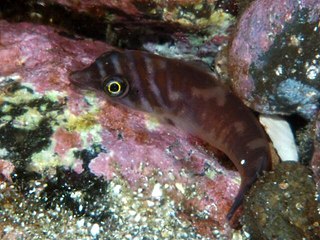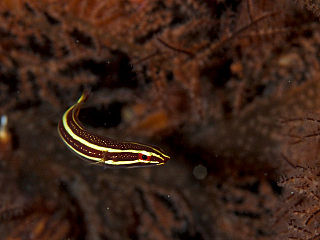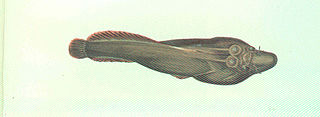The New Zealand urchin clingfish is a clingfish. It is found around New Zealand wherever sea urchins are present. Its length is between 2 and 3 cm.

Clingfishes are fishes of the family Gobiesocidae, the only family in the order Gobiesociformes. These fairly small to very small fishes are widespread in tropical and temperate regions, mostly near the coast, but a few species in deeper seas or fresh water. Most species shelter in shallow reefs or seagrass beds, clinging to rocks, algae and seagrass leaves with their sucking disc, a structure on their chest.
Dellichthys is a small genus of clingfishes from the family Gobiesocidae which are endemic to New Zealand. It had been regarded as a monotypic genus but a second species was described in 2018.

The shore clingfish, Lepadogaster lepadogaster, is a clingfish of the family Gobiesocidae. It is found in the Mediterranean Sea and adjacent Atlantic Ocean north to Galicia, Spain.

Acyrtus is a genus of clingfishes found in the western Atlantic Ocean.

Apletodon is a genus of marine fish in the family Gobiesocidae (clingfishes). The genus was first named by John Carmon Briggs in 1955.
Derilissus is a genus of clingfishes found in the western Atlantic Ocean.

Kopua is a genus of clingfishes found in the Pacific Ocean.
Lecanogaster is a genus of clingfishes from the family Gobiesocidae. They are found in the Atlantic Ocean off the coast of west Africa. The genus was designated as a monotypic genus in 1957 by John C. Briggs but in 2017 a second species was assigned to the genus.

Lepadichthys is a genus of clingfishes native to the Indian and Pacific Oceans.

Lepadogaster is a genus of clingfishes native to the eastern Atlantic Ocean extending into the Mediterranean Sea. Lepadogaster belongs to class Actinopterygii. This means that they share many of the same characteristics as eels, ray-finned fish, and sea horses to name a few. The main characteristic of all of them though is having fin rays. These fin rays are made of webbed skin and are attached to portions of the body that connect fins to the bones. Lepadogaster species have a distinct difference in the formation of their dorsal and anal fins. While most other ray-finned fish spines, branched fin-rays, and middle radials, Lepadogaster species do not have these. Instead, they have cartilage in place of the mentioned features. These clingfish are mainly found near the rocky coasts and inside intertidal zones. Lepadogaster is known mostly as a clingfish, meaning that it spends most of its time attached to the surface of rocks.
Pherallodiscus is a genus of clingfishes native to the central eastern Pacific Ocean along the coast of Mexico. Based on genetic studies the genus should be merged into Gobiesox.

Lepadogaster candolii, common name Connemarra clingfish, is a species of fish in the genus Lepadogaster. It occurs in the Eastern Atlantic from the British Isles south to Madeira and the Canary Islands and into the western Mediterranean and the Black Sea. The specific name candolii honours the Swiss botanist Augustin Pyramus de Candolle (1778-1841) and has various spellings: candolii, candolei, candollei, and decandollii, but only the first one is correct. Some workers have found that L. candolii is not closely related to the other two species in the genus Lepadogaster and have proposed the placing of this species in the revived monotypic genus Mirbelia Canestrini, 1864, at least until more definitive taxonomic studies can be undertaken.

Lepadogaster purpurea, the Cornish sucker, is a species of clingfish from the family Gobiesocidae. It is found in the eastern North Atlantic Ocean and in the Mediterranean Sea.

Apletodon incognitus is a species of clingfish of the family Gobiesocidae. The species is endemic to north-eastern Atlantic Ocean to north-western Mediterranean Sea. The juvenile fish which measure around 1–2 centimetres (0.39–0.79 in) standard length (SL) are frequently recorded as having an association with sea urchins and in beds of Posidonia oceanica. The adults hide under stones covered with red coralline algae and in the empty shells of mussels near beds of Posidonia and Cymodocea nodosa. Within the beds of Posidonia it is often found in sympatry with Opeatogenys gracilis.
The São Tomé clingfish is a species of marine fish of the family Gobiesocidae (clingfish). It grows to 1.4 cm maximal length. It occurs in the eastern Atlantic Ocean, around the islands of São Tomé and Príncipe between 0 and 3 metres depth. The species was first described in 2007 by Ronald Fricke, its specific name honouring the collector of the type, marine biologist Peter Wirtz of Madeira.

Diplecogaster bimaculata, the two-spotted clingfish, is a species of fish in the family Gobiesocidae found in Black Sea, Mediterranean Sea and Atlantic Ocean where it is found on rocks and among seagrass or shell beds.

Apletodon dentatus, the small-headed clingfish, is a species of clingfish from the family Gobiesocidae. It is a benthic fish of shallow, rocky water on the coasts of the eastern Atlantic Ocean and the western Mediterranean Sea.
Diplecogaster tonstricula, the Eastern Atlantic cleaner clingfish, is a species of clingfish from the family Gobiesocidae which is found in the tropical eastern North Atlantic Ocean. It has been observed cleaning larger species of fish.
Opeatogenys gracilis is a species of clingfish from the family Gobiesocidae which is found in the Mediterraean Sea and in the eastern Atlantic Ocean. Suggested common name for this species are the pygmy clingfish and the seagrass clingfish.











